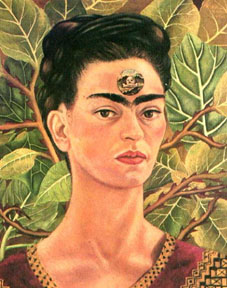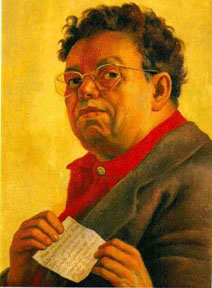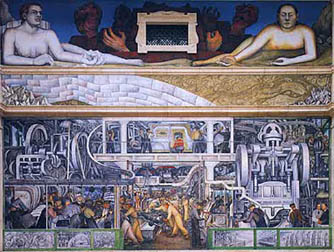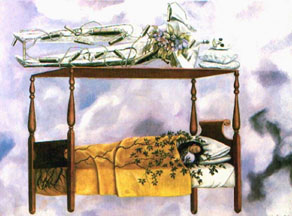.
Frida Kahlo and Diego Rivera
The marriage of Diego Rivera
and Frida Kahlo is one of the most famous alliances between artists. It
is a well-known fact that they had a passionate and stormy relationship,
filled with great love and also betrayals. They both had incredible talents
and vision, but Diego's work would be more public and monumental, whereas
Frida's was more personal and intimate in scale.
I will first explore the development
of Rivera's style of social realism, then attempt to define the surreal
artworks of Kahlo.
Diego
Rivera
(1886-l957)
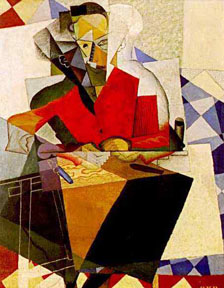
The Architect,
1915
Image Source: Diego Rivera Web Museum
|
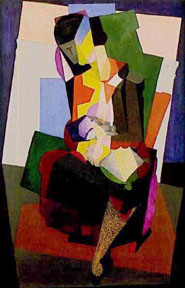
Maternity,
1916
Image Source: Diego Rivera Web Museum
|
Diego Rivera was born in Guanajuato
Mexico in 1886, but moved to Mexico City with his family when he was eight.
He studied in the San Carlos Academy and in the workshop of artist Jose
Guadalupe Posada, who was to influence him greatly. Awarded a scholarship
to study in Europe, he traveled to Paris in 1909. There, he was influenced
by post-impressionism and cubism. He became especially fascinated with Picasso's
cubist works. After some cubist experiments of his own, he became disenchanted
with the elitist art world. In 1920, he went to Italy to study Renaissance
art .
| When he returned
to Mexico, Rivera quickly rediscovered his roots. He decided that he
wanted to create paintings which would speak directly to the common
people. Active in the socialist revolution in Mexico, he felt that art
could play a part in this by educating the Mexicans about their history.
His public murals illustrate hispanic culture's proud pre-Columbian
past, their conquest by the Spanish, the conversion from their native
religion to Catholicism, the submission of the working class by agricultural
tyrannies, and the Mexican Revolution. |
 The Aztec World,
fresco 1929-1935
The Aztec World,
fresco 1929-1935
National Palace, North Wall Mexico
City
Image Source: Diego Rivera Web Museum |
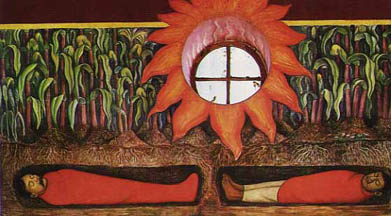
Blood of the Revolutionary
Martyrs Fertilizing the Earth 1926
(Universidad Autonoma de Chapingo Chapel, Chapingo
Mexico)
|
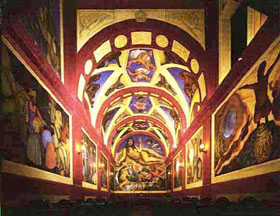
Chapingo Chapel: Subterannean Forces Murals 1926
Image Source: Diego Rivera Web Museum
|
In addition to images
about Mexico's history and revolution, Diego loved to paint ordinary Mexican
life in smaller paintings. In these, he continues to use very bright colors
and simplified compositions. Common subjects in his paintings were: the earth,
the farmer and the laborer.
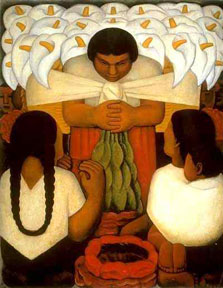
Dia de la Flor (Flower
Day) 1925
Image Source: Diego Rivera Web Museum
|
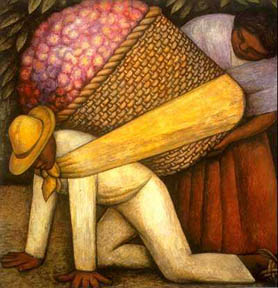
The Flower Carrier (Cargador de Flores) 1935
San Francisco Museum
of Modern Art San Francisco, CA
Image Source: The Artchive
|
In 1932 (after his divorce to his first wife and marriage to Frida Kahlo),
Diego comes to America to complete a commission for Edsel Ford. The commissioned
murals are created in the garden Court of the Detroit Institute of Art, illustrating
the work force of the Ford auto factory. By the following year, the murals
are completed. It is quite ironic that Rivera, a communist, would create a
mural for the greatest industrialist of the age, but the murals are subtly
infused with his own ideologies. Rivera sees the Industrial Revolution as
a liberator of the laborer. All of the workers in his paintings work together
like cogs of a great machine, no one serving a greater role than any other.
Above the murals, he creates more allegorical images relating to the power
of the people, combining images of caucasian, oriental, hispanic and black
figures. Industrialization, he felt, would equalize the races as well as the
social classes.
Detroit Industry, North and South Walls 1932-1933
Fresco: Detroit Institute of Arts Detroit, MI Image Source:
The Artchive
Rivera's next mural was created
in the Rockefeller Center in New York City. It would have a more controversial
history. Known as "Man at the Crossroads", Rivera's long title
for the fresco was "Man at crossroads looking with hope and high vision
to the choosing of a new and better future". Though most of the mural was
deemed successful and acceptable, Nelson Rockefeller asks Rivera to replace
the face of Lenin (the communist leader) with that of an anonymous individual.
Rivera offers to substitute Abraham Lincoln and other 19th century American
figures for a group opposite Lenin. Unable to come to a satisfactory compromise,
Rivera is discharged from the commission. The mural is destroyed. In 1934,
Rivera reproduces a smaller version of the mural on a wall at the Palacio
de Bellas Artes in Mexico City.
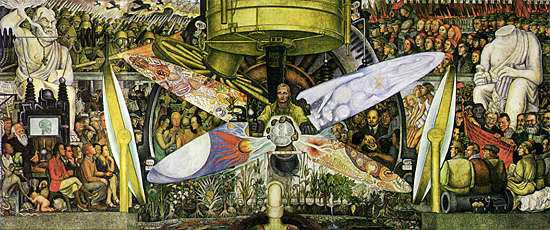
Man at the Crossroads (Hombre
en una Encrucijada) Fresco, 1934
Museo del Palacio de Bellas Arte, Mexico City
Image Source: Diego Rivera Web Museum
Frida
Kahlo
(1907-1954)
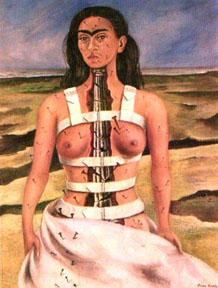
The Broken Column 1944
Image Source: Heyden Herrera,
Biography of Frida Kahlo, 1983
|
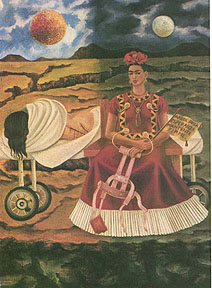
Tree of Hope 1946
Image Source: Heyden Herrera,
Biography of Frida Kahlo, 1983
|
While Rivera's art
looked outward, to social themes - Kahlo's looked inward, to intensely personal
expressions. This was largely due to physical ailments which caused her great
pain throughout her life. Frida was the daughter of a Mexican-Indian mother
and a German father. At age 6, she was stricken with polio, which caused her
right leg to shrivel (something she later hid beneath her long Mexican dresses).
When she was 18, she was involved in a serious bus accident which left her
with a broken spinal column, collarbone, ribs, pelvis, and 11 fractures in
her right leg. In addition her right foot was dislocated and crushed, and
her shoulder was out of joint. For a month at a time, Frida was forced to
stay flat on her back, encased in a plaster cast. She began painting shortly
after the accident because she was bored in bed.
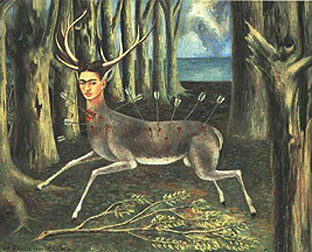
The Little Deer 1946
Image Source: Heyden Herrera,
Biography of Frida Kahlo, 1983
|
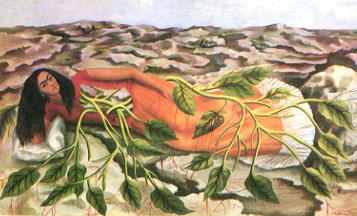
Roots 1943
Image Source: Heyden Herrera,
Biography of Frida Kahlo, 1983
|
Frida's recovery was miraculous,
and she regained her ability to walk. However, she had frequent relapses
of pain all throughout her life, which caused her to be hospitalized for
long periods of time. Maintaining her sense of humor, she joked that she
held the record for the most operations (about 30 in her lifetime). She
also turned to alcohol, drugs, and cigarettes to ease the pain of her physical
suffering. Her images focus on representations of herself, pictures of her
physical pain, emotional longing, and her felt connection to the natural
world.
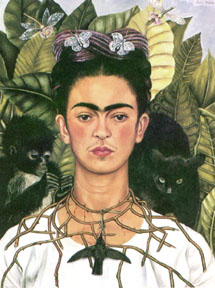
Self Portrait with Thorn
Necklace and Hummingbird 1940
Image Source: Heyden Herrera,
Biography of Frida Kahlo, 1983
|
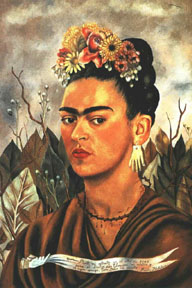
Self Portrait Dedicated
to Dr. Eloesser and Daughters 1940
Image Source: Heyden Herrera,
Biography of Frida Kahlo, 1983
|
Despite tremendous physical ailments,
Frida was a very beautiful woman. She had particularly thick, hairy eyebrows,
which she made no attempt to disguise. In fact, she emphasized them so much
in her paintings that they have become her trademark. It was Rivera who encouraged
Kahlo to wear the traditional embroidered dresses and hair ribbons of the
Tehuanas(a matriarchal Indian tribe). The "hand" earring that she
wears in a couple of her portraits was given to her by Pablo Picasso, whom
she met after marrying Diego Rivera. Their marriage has been called the union
between an elephant and a dove, because Diego was huge and Frida was small
and slender.
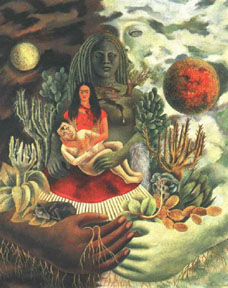
The Love Embrace of
the Universe 1949
Image Source: Heyden
Herrera, Biography of Frida Kahlo, 1983
|
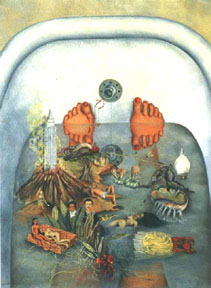
What the Water Gave
Me 1938
Image Source: Heyden
Herrera, Biography of Frida Kahlo, 1983
|
Diego and Frida's marriage was
nothing less than stormy. They loved each other very much, but Diego was
a well-known womanizer, and had several affairs throughout the course of
their marriage (including one with Frida's sister). After much emotional
torment, Frida also had several affairs (with both men and women). Frida
poured out her emotions in her paintings. In The Love Embrace of the
Universe (The Earth, Diego, and Me), she cradles her husband
like a baby while the couple is embraced by an image of the earth and the
universe. In What the Water Gave Me, she also makes reference to
a miscarriage, her move to New York city (the Empire State building emerging
from the volcano), her physical suffering and her complex emotions of love
and rage.
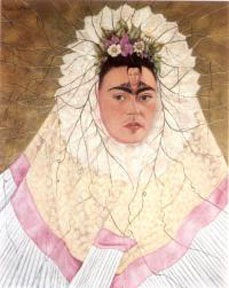
Diego on My Mind 1943
(Frida as Tehuana)
|

The Two Fridas 1939
Image Source: Rita Gilbert'sLiving with Art
|
In 1940, Frida and Diego divorced,
but the separation only lasted one year. Just before their separation, Frida
painted a double self-portrait. In the image on the right, she is dressed
as a Mexican peasant, holding a miniature portrait of Diego. An artery wraps
around her and is connected to an image of herself in a fancy European dress,
holding forceps to prevent further bleeding. It is supposed that this is the
two sides of herself: the one which Diego loves and the other which he does
not. It also relates to her split heritage of Germanic and Mexican blood.
After the couple's reconciliation, Frida painted an image of herself with
Diego on her forehead. She seems to say that she cannot live without him and
cannot get him off of her mind. Despite Diego's affairs with other women,
he helped in many ways. He believed in her and felt that she was the greatest
Mexican woman artist. He introduced her to the art community of Mexico and
New York. I suppose you could also say that their conflicts continued her
desire to express herself as a needed emotional release.
When Andre Breton (the leader
of Surrealism) tried to convince Frida to join the group, she would
have nothing to do with it. "They thought I was a Surrealist, but I
wasn't,'' she said. "I never painted dreams. I painted my own reality.''
During her own lifetime Frida
owed much of her renown as a painter to the fact that she was married
to Diego Rivera. After years in his shadow, she is now even more famous
than her husband. By the early 1980s his social realist murals began
to look outdated, and Kahlo was being rediscovered. Her portrayal of
her own physical and emotional pain spoke to a new generation of feminists
and to those more concerned with personal feeling than grand ideologies. |
|
It is possible that Diego himself
knew that some day Frida would be even more immortal than himself. In 1953,
one year before Kahlo's death, while he was well enshrined as Mexico's greatest
living painter, he gave an interview in which he stated, "Frida Kahlo is
the greatest Mexican painter. Her work is destined to be multiplied by reproductions
and will speak, thanks to books, to the whole world. It is one of the most
formidable artistic documents and most intense testimonies on human truth
of our time.''
Next: The Harlem Renaissance
|

